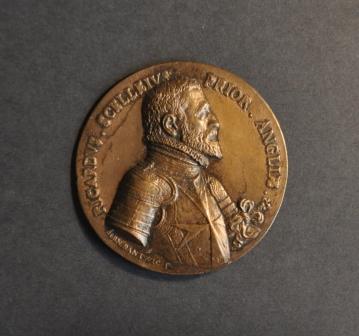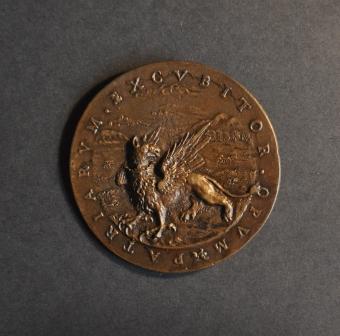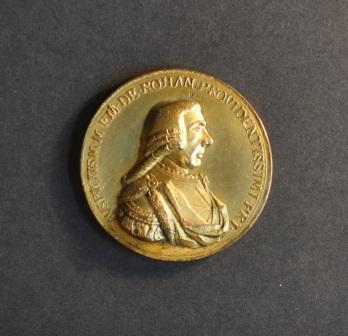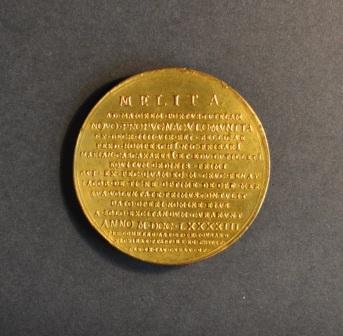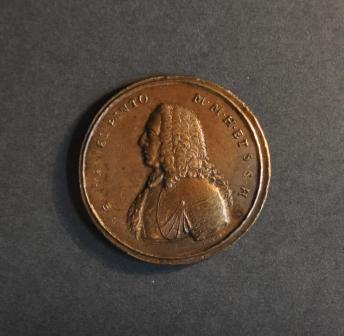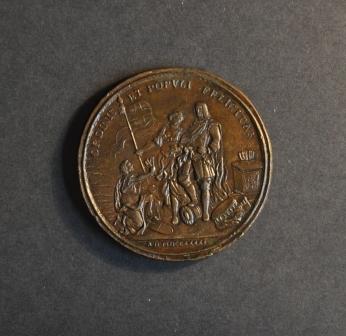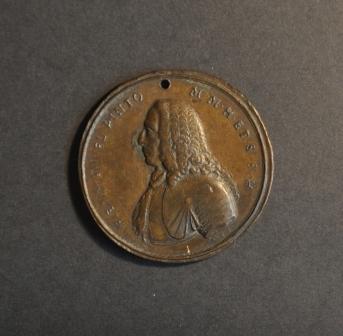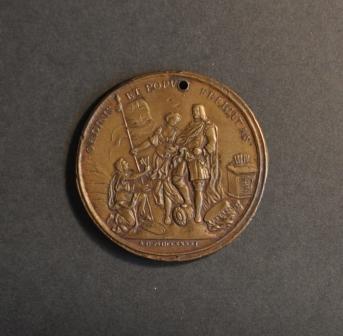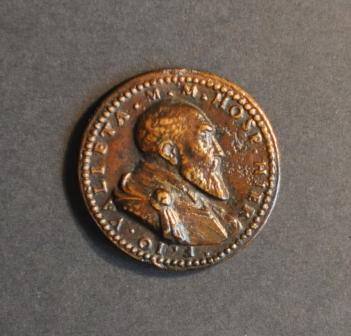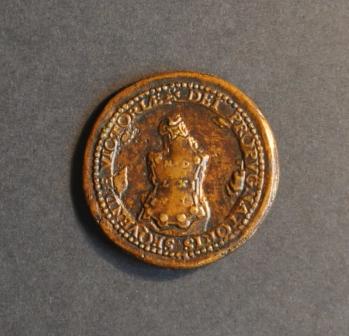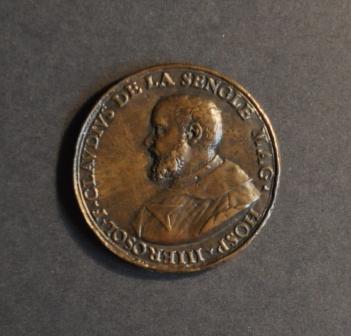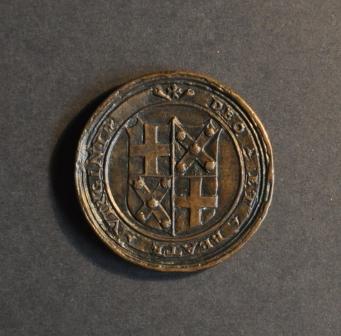Portrait medals can be seen not only as artistic or decorative objects, but also as pieces of history, each with a story to tell. Presented here are some of the medals in the collection of the Museum of the Order of St John, demonstrating the complexity of these little objects and the variety of purposes for which they were made and commissioned.
Portrait medals developed out of a desire to achieve fame and immortality. In early renaissance Italy a new awareness of the self and individualism developed, stressing the importance of personal fame and virtue. Man’s uniqueness was expressed through literature, sculpture and portraiture. Alongside this revival grew a renewed interest in ideas of classical antiquity. The aim was to imitate and restore the glory of ancient Rome. This led to an increased interest in ancient literature and objects. The most commonly found objects were coins, which were sought by collectors. The portrait medal incorporated all these aspects of renaissance culture. Taking its inspiration from ancient Imperial Roman coins, the medal, with the likeness of the subject on one side and an allegorical or emblematic image on the reverse, served as an expression of identity and commemorated the achievements of the person portrayed. The role of the reverse was to offer an insight into the inner being or extoll the virtues of the subject of the medal. But the designs were also open to interpretation and sometimes deliberately obscure in order to limit their understanding to a more cultured elite. Medals, more often than not, represented persons of importance – princes and members of their court, popes and dignitaries of the church – but were also commissioned by collectors of antiquities and patrons of the arts. As medals became fashionable, a wider range of people began to request to have them made. Among the earliest medals commissioned in England was that of John Kendal, prior of St John in England and turcopolier of Rhodes (1477-1501). Several priors and grandmasters of the Order of St John throughout the sixteenth and seventeenth centuries had portrait medals made to celebrate their election or their achievements. Medals were made or commissioned for a variety of purposes. They could be widely distributed to commemorate victory in battle, celebrate a coronation or record the erection of a new building or public monument. However, medals could also be very personal in nature, sometimes expressing religious views or political affiliations, and given only to a close inner circle of acquaintances.
Expressions of Triumph
The celebration of triumph in military encounters was a popular subjects for medals. The reverse of the medal of Grandmaster Jean Parisot de Valette (1557-68), celebrating his victory at the great siege of Malta, shows the biblical scene of David defeating Goliath to represent de Valette’s victory over a superior Turkish force. The subject of the medal presented as a figure from antiquity symbolically endowed them with the attributes associated with the legend. The inscription – UNUS X MILlIA [One (has slain) ten thousand] – is likewise taken from the biblical account of David slaying Goliath, and refers to the praise David received from the Israelite women on his return from the battle. The representation of victory in medals followed classical tradition and was not an attempt at historical documentation. The reverse of Grandmaster Antonio Manoel de Vilhena’s 1729 medal depicts a warrior in Roman guise. The soldier, having triumphed over enemies, receives tribute from the Church. The crescent moon on the shield below the soldier’s feet indicates these enemies were Turks. The medal commemorated Pope Benedict XIII’s gift of a jewelled sword and helmet in recognition of Vilhena’s continued exploits against the Ottoman Turks. The legend on the reverse of the medal lauds INSIGNIS GLORIA FACTI (the glory of distinguished action). These medals demonstrate how the image of triumph could be used to stress the power and glory of the subject.




The medal of Cosimo I de Medici (1537-74) was part of a series made to celebrate his son’s marriage in 1565. However, the original design of the medal may have dated from 1561, commemorating Cosimo’s annexation of Sienna. The legend on the reverse reads HERUTRIA PACATA [Tuscany pacified], and both celebrated a victory and underlined the duke’s authority.


Establishing Authority
Portrait medals and their allusion to ancient imperialism could also be put to more practical use. In a similar way to coins, princes and politicians commissioned medals to help establish and highlight their authority. When Hugues Loubenx de Verdalle was elected grandmaster (1581-95), the order was torn by internal rivalries. He had the difficult task of uniting the warring factions. The legend on the reverse of the medal he commissioned in 1586 states GRATIA DEI UNITI GEMINAMUR [we are united having been joined together by the grace of God]. Throughout his reign Verdalle made a concerted effort to exert and increase the powers of his office. The medal, showing the grandmaster’s coat-of arms, also incorporated a ducal coronet for the first time. This emphasised Verdalle’s position and authority.
A grandmaster who lived too long posed problems for those in the Council who wished to influence or control the direction of the Order, or promote their own ideas and interests. The long reign of the elderly Grandmaster Manuel Pinto da Fonseca (1741-73) meant that he needed to continually assert his authority over ambitious men waiting to take his place. The legend surrounding his portrait declares him to be ‘Prince of Malta’, and the scene on the reverse includes a crescent moon, Pinto’s armorial symbol.




Laying Foundations
Following what was believed to be common practice in classical times, medals were placed in the foundations of buildings and monuments. These medals played the role of a talisman safeguarding the building, as well as being a note to posterity. Following his victory in the great siege of Malta, Grandmaster de Valette had specially commissioned medals and circulating coins placed within the foundation stone of his new city of Valletta. The foundation stone was carved with a Maltese cross and had a cavity cut into it specially to hold the pieces. One of these medals features an outline of Malta on the reverse, surrounded by warships, with the legend MELITA RENASCENS [Malta reborn]. Grandmaster Martin Garzes (1595-1601) commissioned a medal bearing his arms for his fortifications on the Maltese island of Gozo, and a medal of Grandmaster Vilhena commemorates the building of Fort-Manoel. A medal of Grandmaster Alof de Wignacourt (1601-22) marks the construction in 1610 of the aqueduct supplying water to the city of Valletta.








Princes of Malta
Grandmasters of the Order commissioned portrait medals to celebrate their election and coronation. The ceremonies related to the coronation of the grandmasters in Malta became more elaborate with time. On Malta the grandmaster was effectively sole ruler of a small independent state. Verdalle had introduced the ducal coronet into the grandmasters’ armorial shield. When Pinto became grandmaster in 1741, he took the closed crown as his symbol of office, indicating his status as a monarch. The medal celebrating Francisco Ximenes de Texada’s election in 1773 features symbols of wealth and prosperity: two cornucopia, or horns of plenty, and two ears of corn flanking a caduceus. The caduceus was the staff of Hermes or Mercury in Greek and Roman mythology. It became a symbol of trade and commerce, though it was sometimes used to represent alchemy – and by extension medicine and healing. The legend of Ximenes de Texada’s medal celebrates TEMPORUM FELICITAS [Good fortune of the times]. Grandmaster Emmanuel de Rohan-Polduc’s medal for his coronation in 1775 emphasised glory and victory. The reverse depicts the personification of Victory blowing a trumpet and holding a wreath and the legend declaring GLORIA EIUS PER ORBEM TERRARUM (His glory throughout the world). And while the medals of previous grandmasters had included their official title, in the legend surrounding his portrait, Rohan styled himself simply as Prince of Malta. The office of grandmaster became invested with the attributes of royalty.




A Personal Touch
Some medals were more personal and had only a narrow circulation. They could be made to express religious affiliations or political allegiances. The medals of Richard Shelley, the last grand prior of the knights of St John in England (1566-87), seem to refer to his difficulties in belonging to a Catholic Order while retaining allegiance to a Protestant country. An able diplomat, he served the English crown many times in that capacity. He was nevertheless viewed with some suspicion, particularly during the reign of Elizabeth I, on account of his strong adherence to Catholicism. Desiring to convert England back to the old religion, though without the use of force, Shelley aspired to mediate between England and the papacy but was never able to do so. He spent most of his life away from his home country. Even when, towards the end of his life, he was given a passport to return he did not use it, perhaps fearing he would not be allowed the religious freedom which had been promised. The legend on the reverse of one of his medals reads PRO FIDE SPOLIATI CLYPEUS OBSES [His shield is the security of the despoiled on account of faith].


Faith is also the theme of a late medal of Cosimo III de Medici, Grand Duke of Tuscany (1670-1723). The medal shows, on the reverse, St Joseph presenting the Christ child with a lily, a symbol of purity and chastity. Angels hold the Medici coat of arms above, thus associating the deeply religious duke with the sanctity of the scene.





